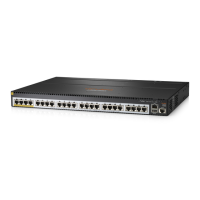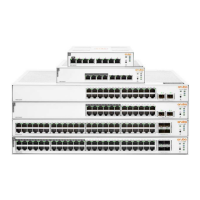168
4. The provider PE advertises VPN-IPv4 routes carrying the comprehensive VPN information to
the other PEs of the service provider.
5. After another provider PE receives the VPN-IPv4 routes, it matches the VPN-IPv4 routes to the
import targets of its local VPNs. Each local VPN accepts routes of its own and advertises them
to provider CEs. If a provider CE (such as CE 7 and CE 8 in Figure 52) is connected to a
provider PE through an IPv4 connection, the PE advertises IPv4 routes to the CE. If it is a
VPN-IPv4 connection (a customer MPLS VPN network), the PE advertises VPN-IPv4 routes to
the CE.
6. After receiving VPN-IPv4 routes from the provider CE, a customer PE matches those routes to
local import targets. Each customer VPN accepts only its own routes and advertises them to
connected customer CEs (such as CE 3, CE 4, CE 5, and CE 6 in Figure 52).
HoVPN
Hierarchy of VPN (HoVPN), also called Hierarchy of PE (HoPE), prevents PEs from being
bottlenecks and is applicable to large-scale VPN deployment.
HoVPN divides PEs into underlayer PEs (UPEs) or user-end PEs, and superstratum PEs (SPEs) or
service provider-end PEs. UPEs and SPEs have different functions and comprise a hierarchical PE.
The HoPE and common PEs can coexist in an MPLS network.
Figure 53 Basic architecture of HoVPN
As shown in Figure 53, UPEs and SPEs play the following different roles:
• A UPE is directly connected to CEs. It provides user access. It maintains the routes of directly
connected VPN sites. It does not maintain the routes of the remote sites in the VPN, or it only
maintains their summary routes. A UPE assigns inner labels to the routes of its directly
connected sites, and advertises the labels along with VPN routes to the SPE through MP-BGP.
A UPE features high access capability, small routing table capacity, and low forwarding
performance.
• An SPE is connected to UPEs and is in the internal network. It manages and advertises VPN
routes. It maintains all the routes of the VPNs connected through UPEs, including the routes of
both the local and remote sites. An SPE advertises routes along with labels to UPEs, including
the default routes of VPN instances or summary routes and the routes permitted by the routing
policy. By using routing policies, you can control which sites in a VPN can communicate with
each other. An SPE features large routing table capacity, high forwarding performance, and
fewer interface resources.
Either MP-IBGP or MP-EBGP can run between SPE and UPE. When MP-IBGP runs between SPE
and UPEs, the SPE acts as the RR of multiple UPEs to reflect routes between UPEs.
MPLS network
PE
PE
SPEUPE
UPE
CE
CE CE CE
VPN 1 VPN
1VPN 2 VPN 2
Site 1 Site 2

